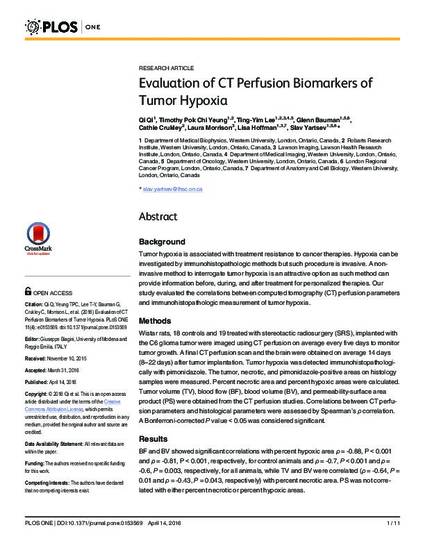
Background Tumor hypoxia is associated with treatment resistance to cancer therapies. Hypoxia can be investigated by immunohistopathologic methods but such procedure is invasive. A noninvasive method to interrogate tumor hypoxia is an attractive option as such method can provide information before, during, and after treatment for personalized therapies. Our study evaluated the correlations between computed tomography (CT) perfusion parameters and immunohistopathologic measurement of tumor hypoxia. Methods Wistar rats, 18 controls and 19 treated with stereotactic radiosurgery (SRS), implanted with the C6 glioma tumor were imaged using CT perfusion on average every five days to monitor tumor growth. A final CT perfusion scan and the brain were obtained on average 14 days (8-22 days) after tumor implantation. Tumor hypoxia was detected immunohistopathologically with pimonidazole. The tumor, necrotic, and pimonidazole-positive areas on histology samples were measured. Percent necrotic area and percent hypoxic areas were calculated. Tumor volume (TV), blood flow (BF), blood volume (BV), and permeability-surface area product (PS) were obtained from the CT perfusion studies. Correlations between CT perfusion parameters and histological parameters were assessed by Spearman's ρ correlation. A Bonferroni-corrected P value < 0.05 was considered significant. Results BF and BV showed significant correlations with percent hypoxic area ρ = -0.88, P < 0.001 and ρ = -0.81, P < 0.001, respectively, for control animals and ρ = -0.7, P < 0.001 and ρ = -0.6, P = 0.003, respectively, for all animals, while TV and BV were correlated (ρ = -0.64, P = 0.01 and ρ = -0.43, P = 0.043, respectively) with percent necrotic area. PS was not correlated with either percent necrotic or percent hypoxic areas. Conclusions Percent hypoxic area provided significant correlations with BF and BV, suggesting that CT perfusion parameters are potential non-invasive imaging biomarkers of tumor hypoxia.
Available at: http://works.bepress.com/dr-lisa-hoffman/5/
